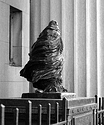The leading mfg for registration gear for camera film was Condit, but it's getting difficult to find complete matched sets anymore, though once in awhile they do come up if you're patient. Durst had their own system, but it's even harder to find in good condition. If a person has some basic machine shop skills and access to a precision drill press or milling machine (not the kind of thing you buy at Sears), you could make your own gear or refurbish older equip. In terms of new stuff, Inglis and Radeka (sp?) have a limited amount up to 4x5, but I'm not personally familiar with it. It's easy to get punch and register gear for larger sizes of film, either used, or still in mfg from outfits like Olec-Stoesser and Ternes-Burton, but this is really matched to big sheet goods, like used in the printing industry or for large contact prints. Registering film by
eye over a lightbox can be done for the basic learning curve; but too much of that and you'll go insane.






